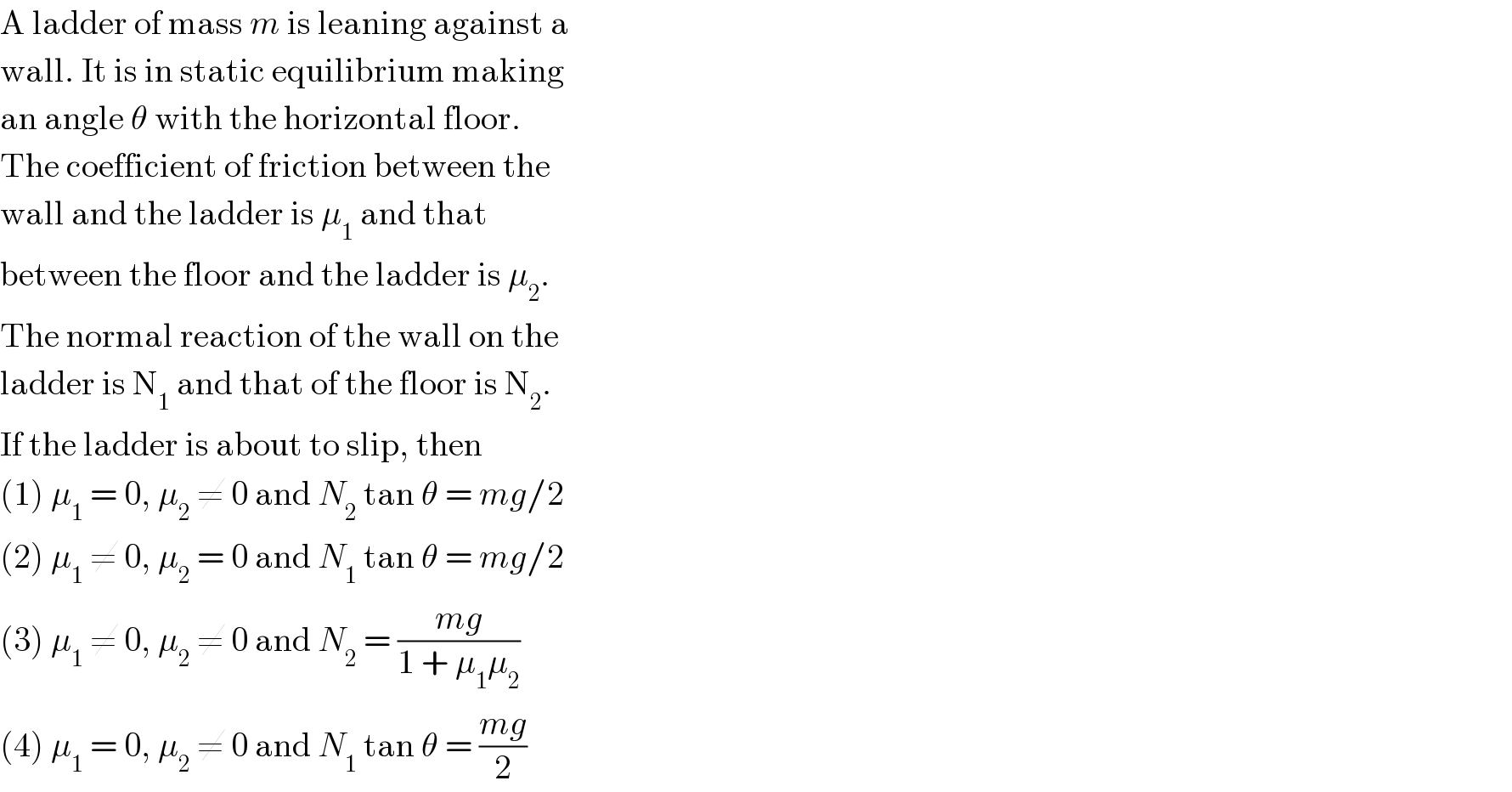
Question Number 22479 by Tinkutara last updated on 19/Oct/17

$$\mathrm{A}\:\mathrm{ladder}\:\mathrm{of}\:\mathrm{mass}\:{m}\:\mathrm{is}\:\mathrm{leaning}\:\mathrm{against}\:\mathrm{a} \\ $$$$\mathrm{wall}.\:\mathrm{It}\:\mathrm{is}\:\mathrm{in}\:\mathrm{static}\:\mathrm{equilibrium}\:\mathrm{making} \\ $$$$\mathrm{an}\:\mathrm{angle}\:\theta\:\mathrm{with}\:\mathrm{the}\:\mathrm{horizontal}\:\mathrm{floor}. \\ $$$$\mathrm{The}\:\mathrm{coefficient}\:\mathrm{of}\:\mathrm{friction}\:\mathrm{between}\:\mathrm{the} \\ $$$$\mathrm{wall}\:\mathrm{and}\:\mathrm{the}\:\mathrm{ladder}\:\mathrm{is}\:\mu_{\mathrm{1}} \:\mathrm{and}\:\mathrm{that} \\ $$$$\mathrm{between}\:\mathrm{the}\:\mathrm{floor}\:\mathrm{and}\:\mathrm{the}\:\mathrm{ladder}\:\mathrm{is}\:\mu_{\mathrm{2}} . \\ $$$$\mathrm{The}\:\mathrm{normal}\:\mathrm{reaction}\:\mathrm{of}\:\mathrm{the}\:\mathrm{wall}\:\mathrm{on}\:\mathrm{the} \\ $$$$\mathrm{ladder}\:\mathrm{is}\:\mathrm{N}_{\mathrm{1}} \:\mathrm{and}\:\mathrm{that}\:\mathrm{of}\:\mathrm{the}\:\mathrm{floor}\:\mathrm{is}\:\mathrm{N}_{\mathrm{2}} . \\ $$$$\mathrm{If}\:\mathrm{the}\:\mathrm{ladder}\:\mathrm{is}\:\mathrm{about}\:\mathrm{to}\:\mathrm{slip},\:\mathrm{then} \\ $$$$\left(\mathrm{1}\right)\:\mu_{\mathrm{1}} \:=\:\mathrm{0},\:\mu_{\mathrm{2}} \:\neq\:\mathrm{0}\:\mathrm{and}\:{N}_{\mathrm{2}} \:\mathrm{tan}\:\theta\:=\:{mg}/\mathrm{2} \\ $$$$\left(\mathrm{2}\right)\:\mu_{\mathrm{1}} \:\neq\:\mathrm{0},\:\mu_{\mathrm{2}} \:=\:\mathrm{0}\:\mathrm{and}\:{N}_{\mathrm{1}} \:\mathrm{tan}\:\theta\:=\:{mg}/\mathrm{2} \\ $$$$\left(\mathrm{3}\right)\:\mu_{\mathrm{1}} \:\neq\:\mathrm{0},\:\mu_{\mathrm{2}} \:\neq\:\mathrm{0}\:\mathrm{and}\:{N}_{\mathrm{2}} \:=\:\frac{{mg}}{\mathrm{1}\:+\:\mu_{\mathrm{1}} \mu_{\mathrm{2}} } \\ $$$$\left(\mathrm{4}\right)\:\mu_{\mathrm{1}} \:=\:\mathrm{0},\:\mu_{\mathrm{2}} \:\neq\:\mathrm{0}\:\mathrm{and}\:{N}_{\mathrm{1}} \:\mathrm{tan}\:\theta\:=\:\frac{{mg}}{\mathrm{2}} \\ $$
Commented by Tinkutara last updated on 19/Oct/17

Commented by ajfour last updated on 19/Oct/17

$$\left(\mathrm{3}\right)\:{and}\:\left(\mathrm{4}\right)\:{are}\:{correct}. \\ $$$${See}\:{Q}.\mathrm{22481}\:{for}\:{solution}. \\ $$
